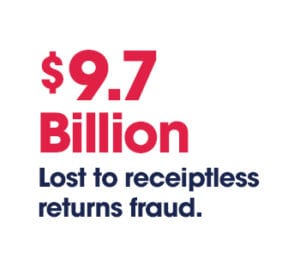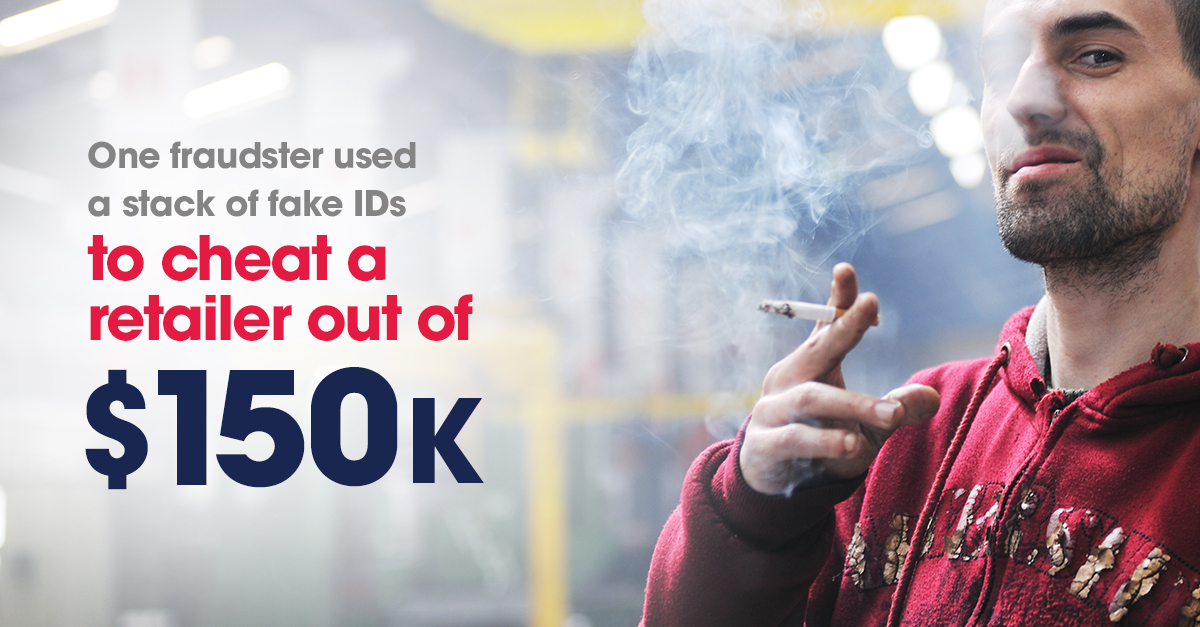Fake IDs are undermining your returns policy.
Yes, you limit the number of returns a customer can make without a receipt in a certain time period, and you collect driver’s license data to check IDs against that policy. Maybe you’re even using predictive analytics to identify potential fraudsters. But those efforts are insufficient if your database is muddied by fake IDs.
In our ongoing blog series on receiptless returns fraud, we’ve been examining the impact of receiptless returns fraud and exploring proactive options to help you combat this often overlooked source of retail fraud.
Today, we’re turning the conversation to the pervasive problem of fake IDs.
Fraudsters Use Fake IDs to Out-Maneuver Retailers
Both individuals and organized retail crime rings are increasingly turning to fake IDs to take advantage of generous customer service policies. And the losses are adding up: $9.7 billion a year according to recent research.
While each retailer sets its own unique policies (e.g. certain number of returns allowed without a receipt in a specific time period), they’re no match for savvy fraudsters who sleuth out imposed limits. The fraudsters figure out the brand’s rules and change behavior accordingly. Once they’ve neared the maximum number of allowed receiptless returns with a fake ID, they simply start using a new one.


In one case, a fraudster used a stack of fake driver’s licenses to return nearly $150,000 in stolen merchandise at a well-known retailer without receipts. The fraud took place over the course of several months and across six states.
For brands with seemingly sophisticated loss prevention systems, how is this level of deception possible?
Most Fraud Protection Solutions Don’t Catch Fake IDs
According to NRF, 73 percent of retailers require an ID to perform a merchandise return without a receipt. Retailers record driver’s license data (DLD) to enforce their return policy, making sure that a customer doesn’t exceed the number of allowable returns within a certain timeframe. However, there are no measures in place to actually verify the IDs, which makes it impossible to know if the customer is presenting a valid driver’s license or using a fake ID to perpetrate fraud.
Return optimization solutions based on predictive analytics are no more effective at catching fake IDs. At best, fraud scoring stops returns fraud only after a certain amount of fraud has already occurred. And fraud scoring on fake IDs has no value — fraudsters simply put a new fake ID into circulation and continue their scheme undetected.
The result is a database dirtied by fake IDs. If you’re storing millions of customer IDs, it can be overwhelming to try to determine which are valid driver’s licenses and which are fake.
Most retailers underestimate the number of fake IDs that already exist in their database. And when you underestimate the number of fake IDs, you likely misjudge the impact on your bottom line.
Fraudsters Use Fake IDs to Out-Maneuver Retailers
Both individuals and organized retail crime rings are increasingly turning to fake IDs to take advantage of generous customer service policies. And the losses are adding up: $9.7 billion a year according to recent research
While each retailer sets its own unique policies (e.g. certain number of returns allowed without a receipt in a specific time period), they’re no match for savvy fraudsters who sleuth out imposed limits. The fraudsters figure out the brand’s rules and change behavior accordingly. Once they’ve neared the maximum number of allowed receiptless returns with a fake ID, they simply start using a new one.


Digital Verification Identifies Fake IDs
The key is to catch and prevent the fraud right in the moment that the fake ID is presented. This requires Digital Verification— a solution that allows you to instantly determine during a transaction if a driver’s license or other state-issued ID is valid.
Digital Verification complements your existing returns policy and analytics solutions by allowing you to proactively identify and prevent the use of fake IDs to perpetrate receiptless returns fraud.
You can also use Digital Verification to perform a batch audit of IDs stored from historical transactions to identify fraudulent DLD, then update your returns database to prevent future merchandise returns with the same fake ID.
In one DLD audit we performed, the retailer was shocked to find out that almost 1 percent of their stored driver’s licenses were fraudulent. While at first blush that might not seem like an exceptionally large number, the retailer attributed millions of dollars of fraud loss to the use of those fake IDs. They immediately flagged those IDs as fake so they could no longer be used to perpetrate fraud.
Surprisingly, the retailer was checking IDs against their return policy and even had a return optimization solution in place, yet without a way to initially identify the driver’s licenses as fraudulent, they were losing money because those solutions weren’t sufficient. The fraudsters still snuck through.
Auditing Your Driver’s License Data
Ready to take control of your returns database and weed out fake IDs? Here’s how we conduct a DLD audit:
- SheerID runs a verification check on DLD from historical transactions to identify fake IDs
- Retailer flags those IDs as fraudulent
- Fraudsters are prevented from using flagged fake ID for future returns
- Digital Verification can then be used on an ongoing basis to verify every driver’s license used in a return transaction in real time








